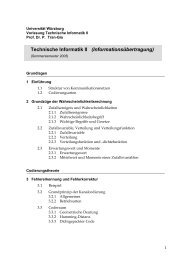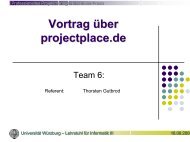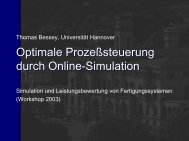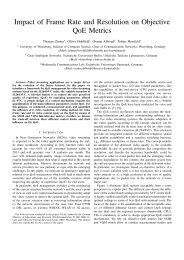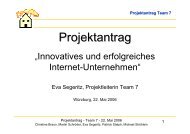Measurement and Analysis of Skype VoIP Traffic in 3G UMTS Systems
Measurement and Analysis of Skype VoIP Traffic in 3G UMTS Systems
Measurement and Analysis of Skype VoIP Traffic in 3G UMTS Systems
You also want an ePaper? Increase the reach of your titles
YUMPU automatically turns print PDFs into web optimized ePapers that Google loves.
voice calls us<strong>in</strong>g <strong>Skype</strong> is analyzed by perform<strong>in</strong>g measurements <strong>in</strong> a real <strong>UMTS</strong> network <strong>and</strong>additionally <strong>in</strong> a test environment. The testbed is used to emulate rate control mechanisms <strong>and</strong>chang<strong>in</strong>g radio propagation conditions <strong>in</strong> <strong>UMTS</strong>. The results show how <strong>Skype</strong> reacts to network<strong>in</strong>fluences <strong>and</strong> if <strong>Skype</strong> over <strong>UMTS</strong> keeps pace with exist<strong>in</strong>g mobile telephony systems. The<strong>in</strong>vestigated performance measures are the Perceptual Evaluation <strong>of</strong> Speech Quality (PESQ)for evaluat<strong>in</strong>g the voice quality, the packet loss, the <strong>in</strong>ter-packet delay, <strong>and</strong> the throughput fordescrib<strong>in</strong>g the network-based factors. The concept <strong>of</strong> the Network Utility Function (NUF) [4] isapplied to describe the impact <strong>of</strong> the network on the perceived voice quality.The rema<strong>in</strong>der <strong>of</strong> this work is organized as follows. In Section 2, the setups for the bottleneckLAN measurements <strong>and</strong> for the <strong>UMTS</strong> measurements are shown. Section 3 describes theperformance objectives <strong>and</strong> measures. The measurement results <strong>and</strong> the analysis <strong>of</strong> the <strong>Skype</strong>application <strong>in</strong> the different scenarios are given <strong>in</strong> Section 4. In particular, Section 4.1 coversthe bottleneck LAN which emulates chang<strong>in</strong>g wireless conditions by adapt<strong>in</strong>g the transmissionrate. The measurements <strong>in</strong> the real <strong>UMTS</strong> networks are evaluated <strong>in</strong> Section 4.2. In Section 4.3,we apply the network utility function which uses network-based parameters, like packet loss ordelay, as <strong>in</strong>put <strong>in</strong> order to derive the user perceived quality. F<strong>in</strong>ally, Section 5 concludes thiswork <strong>and</strong> gives an outlook for the next steps <strong>of</strong> the performance evaluation <strong>of</strong> <strong>Skype</strong>.2 <strong>Measurement</strong> Setup <strong>and</strong> ScenarioThe general measurement setup is the follow<strong>in</strong>g: <strong>Skype</strong> user A sends audio data to <strong>Skype</strong> userB. We used an English spoken text without noise, a sample rate <strong>of</strong> 8 kHz, encoded with 16 bitsper sample which is a st<strong>and</strong>ard audio file for evaluat<strong>in</strong>g <strong>VoIP</strong> <strong>and</strong> available at [5]. The wav-file isplayed with the W<strong>in</strong>amp audio player on mach<strong>in</strong>e A. The output <strong>of</strong> W<strong>in</strong>amp is used as <strong>in</strong>put for<strong>Skype</strong> (<strong>in</strong>stead <strong>of</strong> a microphone). On sender A <strong>and</strong> receiver B, W<strong>in</strong>dows XP is the OS, <strong>Skype</strong>v1.20.37 is <strong>in</strong>stalled <strong>and</strong> a packet trace is captured with TCPDump on each mach<strong>in</strong>e. In order tosave the received audio data, the output <strong>of</strong> <strong>Skype</strong> has to be forwarded with an audio cable fromB to another mach<strong>in</strong>e.2.1 Bottleneck LAN SetupIn a <strong>UMTS</strong> system, the conditions <strong>of</strong> the wireless channel are chang<strong>in</strong>g over time because <strong>of</strong>radio propagation effects or (slow <strong>and</strong> fast) fad<strong>in</strong>g, especially for a mov<strong>in</strong>g <strong>UMTS</strong> user. Additionally,the system load affects the available b<strong>and</strong>width <strong>of</strong> an arbitrary user. On rate-controlleddedicated channels or us<strong>in</strong>g HSUPA/HSDPA, this results <strong>in</strong> the b<strong>and</strong>with adaptation <strong>of</strong> a <strong>UMTS</strong>subscriber. In the bottleneck LAN scenario, we emulate a <strong>UMTS</strong> user who starts a <strong>Skype</strong> <strong>VoIP</strong>call <strong>and</strong> has an <strong>in</strong>itially assigned b<strong>and</strong>width <strong>of</strong> 16 kbps. Dur<strong>in</strong>g the call, the network conditionschange <strong>and</strong> the user is assigned a higher b<strong>and</strong>width. We <strong>in</strong>creased the b<strong>and</strong>width up to 384 kbpswhich reflects the currently <strong>of</strong>fered downl<strong>in</strong>k b<strong>and</strong>width <strong>of</strong> the public <strong>UMTS</strong> operator. In orderto evaluate <strong>and</strong> compare the perceived voice quality for the different assigned b<strong>and</strong>widths, thesame audio data was transmitted for each measured b<strong>and</strong>width. The b<strong>and</strong>width restriction wasrealized by us<strong>in</strong>g a traffic shap<strong>in</strong>g router, cf. Figure 1.2





